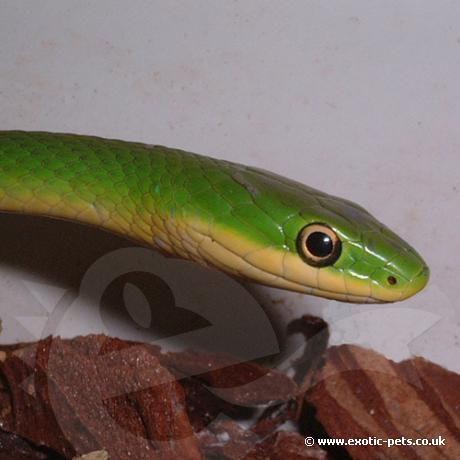

Rough Green Snakes are unlike most snake species as they do not feed on rodents, but eat live insects instead. If you don't like the idea of rodents in your freezer, why not give these a go?
| Origin | Southeast America |
|---|---|
| Environment | Semi-moist meadows and woodland |
| Adult Size | 116cm |
| Suitability | Intermediate |
| Lifespan | Up to 15 years |
| Temperament | Skitty |
This slim and slender snake is bright green in colour, with yellow on the underside and along the mouth. Their eyes are very distinctive and seem to stand out, large eyes are required when searching for insects. When adult, they reach a size of 116cm (45"). They are good climbers and have a long thin tail to help grip on plant stems and with tall grass.
You will find this snake in semi-moist meadows and woodlands of Southeast America, from Florida, New Jersey, Indiana and west to Central Texas.
You can keep Rough Green Snakes in either a vivarium or glass terrarium, the latter is more suitable due to regular misting of water. Being diurnal (active during the day) they can often be found in low shrubs and grasses, therefore, provide a well-planted terrarium. There is a mass selection of artificial plants and decor or, if you want the snakes to feel right at home, provide a bio-active enlcosure. Live plants and running water for Rough Green Snakes will allow them to thrive and probably breed in captivity.
There's a number of different substrates to use from ProRep Bio Life Forest to Zoo Med Forest Floor, both will help keep humidity within the enclosure. You do not want to use Aspen as this is too dry and could cause mould to form with the daily misting that is required.
A daytime temperature of 25-30C (77-86F) with a drop down to 20C (68F) during the night should be provided. UVB lighting must be provided for this snake due to their active nature during the day. Not only is it required for actively seeing and hunting insects but also for the bone and growth development.
Unlike other species of snakes, there are no more defrosting rodents, they eat live insects in captivity with the occasional small lizard and amphibian in the wild. It's best to vary their diet as best as you can via commercial live foods. They seem fond of small locusts and crickets, you can try them on calci worms and waxworms too. It's important to ensure your live food is always gut loaded, passing all the nutritional goodness to your pet. Dusting the insects with a calcium and a good quality vitamin and mineral powder is very important.